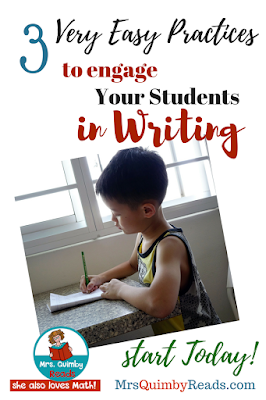 |
| Writing In the Classroom Photo Writing Prompts |
1. First, children need adventures,
experiences and stories to write about...and where will they get them? Teachers can help make a story-filled classroom for their students. Some teachers schedule a story time as part of their literacy practices and strategies. Reading is a wonderful place to start because books are filled with writing, they tell adventures and stories. Telling stories and having conversations about experiences can be a springboard to writing. Reading and listening can be the precursor for writing and speaking. Talk, listen, tell, and write. Tell stories in your classroom, provide opportunities for students to tell their stories. Whenever you become a storyteller, ears start to listen. Be sure to also take the opportunity to look at writing within the texts and books you are reading. Isolating key writing strategies that talented authors use is a great way to show students what a writer does.2. Write!
yes, write and then write some more. Let your students see you write. Write at journal time, write sticky notes, write letters, write, write, write. Put up sticky-notes
on a chalkboard or door. Fill out forms and talk about writing. Write on your blog and text on your phone. Model writing. It is a way we communicate. For younger students, all of these practices show them that words they hear can also be in written form. Another good writing practice is guided writing time, especially for the younger students, write big messages on chart paper. Always have an easel out for shared writing. Think aloud as you write. Solicit help with spelling. Ask students what letters and sounds they hear. Older students can do the same with expanded vocabulary, compound sentences and different kinds of writing.
Another idea: find a small notebook. Label it 'ideas and suggestions' and place it in the classroom where students have access to it. Students write in this notebook when they get an idea! My students love this as they can voice their ideas and opinions. I love it because they are writing and they also suggest some very helpful ways to improve things in our classroom. [oh, and they must sign their name after writing their idea.]
3. Set the Stage
 Pens, paper, pencils, chalk, crayons, white boards, all the kinds and all the colors...have them available. All of the writing utensils and papers invite young writers in the craft of writing. You can organize colored pencils, markers and pens in a writing corner that makes the writing tools ready at all times. Place a bunch of colored pencils in a holder that is labeled for 'colorful writing' and sit back to see! Journal pages that jump off the white page with imagination, intrigue and excitement! Bins, boxes, and all sorted! Young children love to write on the computer, too. Four year olds learn quickly how to change font and size and print! Many of us write on the computer and young writers need to learn early.
Pens, paper, pencils, chalk, crayons, white boards, all the kinds and all the colors...have them available. All of the writing utensils and papers invite young writers in the craft of writing. You can organize colored pencils, markers and pens in a writing corner that makes the writing tools ready at all times. Place a bunch of colored pencils in a holder that is labeled for 'colorful writing' and sit back to see! Journal pages that jump off the white page with imagination, intrigue and excitement! Bins, boxes, and all sorted! Young children love to write on the computer, too. Four year olds learn quickly how to change font and size and print! Many of us write on the computer and young writers need to learn early.Writing spaces can be places where it is so very quiet or a space where writers can share ideas. Your writing space can be in a corner of your classroom or sitting at tables and desks. Often times it is the mood, the opportunity and the quietness that encourages the best writing. Be sure to schedule time in your plan book for quiet, for sharing and talking, and also for teaching [ as in writer's workshop].
4. Using Writing Prompts
Writing prompts can help those who have a bit of trouble getting started... a simple picture or photo can be a valuable writing prompt. See below to get some writing prompts for your classroom. It's easy... 120 photographs that are interesting and start the kids thinking. Create a photo file... lots of interesting photos for your students to write about. Each photo is on a writing prompt page, included to make a photo file and also on a powerpoint presentation to show on your whiteboard.
 |
| Photo Writing Prompts |
 |
| All the work is done for you; Just grab your photo writing prompts HERE |
 |
| 3-2-1 Quick Writes - Students Love These! |
Fun Friday Photo Writing Day!
Sharing writing is also a way to help writers engage...sometimes I give 5-10 minute "talk with your neighbor"
then let's power write ... 15 minutes ...sustained silent writing...oh, silence is golden!


